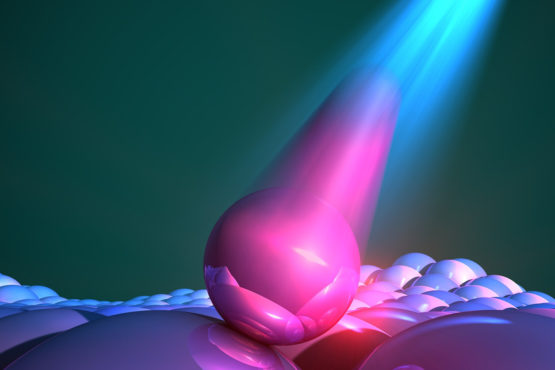
Tiny, easy-to-produce particles, called quantum dots, may soon take the place of more expensive single crystal semiconductors in advanced electronics found in solar panels, camera sensors and medical imaging tools. Although quantum dots have begun to break into the consumer market – in the form of quantum dot TVs – they have been hampered by long-standing uncertainties about their quality. Now, a new measurement technique developed by Foundry users and staff may finally dissolve those doubts. Their work was recently published in Science.
The researchers focused on how efficiently quantum dots reemit the light they absorb, one telltale measure of semiconductor quality. While previous attempts to figure out quantum dot efficiency hinted at high performance, this is the first measurement method to confidently show they could compete with single crystals.
The small size of quantum dots means that it may take billions of them to do the work of one large, perfect single crystal. Making so many of these quantum dots means more chances for something to grow incorrectly, more chances for a defect that can hamper performance. Techniques that measure the quality of other semiconductors previously suggested quantum dots emit over 99 percent of the light they absorb but that was not enough to answer questions about their potential for defects. To do this, the researchers needed a measurement technique better suited to precisely evaluating these particles.
The researchers’ technique involved checking for excess heat produced by energized quantum dots, rather than only assessing light emission because excess heat is a signature of inefficient emission. This technique, commonly used for other materials, had never been applied to measure quantum dots in this way and it was 100 times more precise than what others have used in the past. They found that groups of quantum dots reliably emitted about 99.6 percent of the light they absorbed (with a potential error of 0.2 percent in either direction), which is comparable to the best single-crystal emissions.
Contrary to concerns, the results suggest that the quantum dots are strikingly defect-tolerant. The measurement technique is also the first to firmly resolve how different quantum dot structures compare to each other – quantum dots with precisely eight atomic layers of a special coating material emitted light the fastest, an indicator of superior quality. The shape of those dots should guide the design for new light-emitting materials.
A next step in this project is developing even more precise measurements. If the researchers can determine that these materials reach efficiencies at or above 99.999 percent, that opens up the possibility for technologies we’ve never seen before. These could include new glowing dyes to enhance our ability to look at biology at the atomic scale, luminescent cooling and luminescent solar concentrators, which allow a relatively small set of solar cells to take in energy from a large area of solar radiation. All this being said, the measurements they’ve already established are a milestone of their own, likely to encourage a more immediate boost in quantum dot research and applications.

